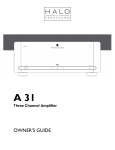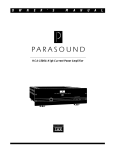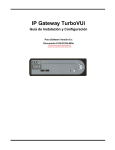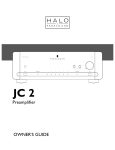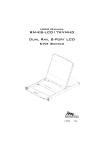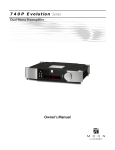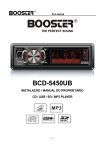Download Parasound A 23 User's Manual
Transcript
A 23 Amplifier Owner’s Guide THANK YOU! Congratulations and Thank You for Choosing Parasound Your new Parasound Halo Series A 23 power amplifier presents the latest advancements in amplifier technology. The A 23 is built to the strict quality and performance standards set by Parasound. We’re proud to offer you this exceptional audio component that will bring you many years of enjoyment and dependability. Here at Parasound, we design our products to perform at a higher level of flexibility and sonic performance than you may have expected. We encourage you to read this entire manual to learn all the features and capabilities of your new Halo Series A 23 Amplifier. If you’re eager to get up and running right away, simply follow the basic step-by-step instructions to connect and operate the A 23. If you want to learn about some of the technical and design aspects of your A 23, refer to the Technically Speaking and Parasound A 23 Design Overview sections in the back of the manual. If you run into difficulties, the Troubleshooting Guide should help you quickly remedy the problem. We appreciate you taking the time to read these instructions and thank you for selecting Parasound for your listening pleasure. The Parasound Staff Unpacking Your A 23 Unpack your A 23 from the shipping carton, remove the enclosed AC power cord, and the control wire with sub-mini 2.5 mm plugs on each end. (This is the trigger connection wire). While you are unpacking your new amplifier, inspect it thoroughly for possible shipping damage. If you see any, contact your Parasound dealer right away. Be sure to save and store both the inner and outer cartons and the packing inserts for possible future transport. To save room for storage, you can cut the seams on the bottom of the cartons and flatten them. Keeping Records for Future Reference Record the serial number located on the bottom of your A 23 in the space below. Also note your Parasound Dealer’s name and phone number. We recommend that you keep your purchase receipt with this manual and store them both in a safe place. You may need to refer to this information sometime in the future. Parasound A 23 Amplifier Serial #: ____________________ Parasound Dealer: ____________________________________ Phone Number:_______________________________________ Date of Purchase: _____________________________________ YOU SHOULD KNOW There is no Parasound warranty for this unit if it was not purchased from an Authorized Parasound Dealer. Investigate any warranty claims made by unauthorized dealers very carefully as you will need to depend entirely upon the dealer, and NOT upon Parasound. Unauthorized dealers may lack the capability to arrange repairs of Parasound equipment. Authorized Parasound Dealers are listed at www.parasound.com or you can call 415-397-7100 between 8:30 am and 4:30 pm Pacific time. A missing or tampered serial number could indicate that this unit was stolen or sold by an unauthorized dealer. If this unit is missing its serial number, you should return it to your dealer immediately for a full refund. TABLE OF CONTENTS A 23 Amplifier 1 PLACEMENT GUIDELINES FOR YOUR A 23 _________________________________________________________________________________ 2 CONNECTING A PREAMPLIFIER OR SURROUND CONTROLLER TO THE BALANCED INPUTS ON THE A 23 _________________________________________________________________________________ 3 CONNECTING A PREAMPLIFIER OR SURROUND CONTROLLER TO THE UNBALANCED INPUTS ON THE A 23 _________________________________________________________________________________ 4 CONNECTING THE LOOP OUT JACKS ON THE A 23 TO ANOTHER POWER AMPLIFIER’S INPUTS _________________________________________________________________________________ 5 CONNECTING SPEAKERS TO THE A 23 _________________________________________________________________________________ 6 CONFIGURING THE A 23 FOR BRIDGED MONO OPERATION _________________________________________________________________________________ 7 MANUAL AND AUTOMATIC TURN ON-OFF OPTIONS _________________________________________________________________________________ 8 CONNECTING AN EXTERNAL DC SOURCE FOR AUTOMATIC ON-OFF _________________________________________________________________________________ 9 CONNECTING THE A 23 TO TRIGGER ANOTHER COMPONENT _________________________________________________________________________________ 10 UNDERSTANDING THE INDICATORS ON THE A 23 _________________________________________________________________________________ 11 CONNECTING THE AC POWER CORD _________________________________________________________________________________ 12 MAINTAINING YOUR A 23 _________________________________________________________________________________ 13 TROUBLESHOOTING GUIDE _________________________________________________________________________________ 14 SERVICING YOUR A 23 _________________________________________________________________________________ 15 TECHNICALLY SPEAKING _________________________________________________________________________________ 17 PARASOUND A 23 DESIGN OVERVIEW _________________________________________________________________________________ 19 PARASOUND A 23 SPECIFICATIONS _________________________________________________________________________________ 1 PLACEMENT GUIDELINES FOR YOUR A 23 Power amplifiers are usually heavier and generate more heat than other components. To avoid damage to the A 23 or other equipment and to reduce risk of fire, you must follow these guidelines: • Place the A 23 on a separate shelf that will adequately support its weight. • Keep it away from heat sources such as air ducts or radiators. • Avoid placing it on carpeting or another material that might obstruct airflow into the openings in the chassis bottom. • Leave at least 3” of space around both sides and the top. The bottom clearance can be a little less. This helps facilitate heat dissipation. • Do not block the front of the A 23 behind closed cabinet doors during use. • Do not stack the A 23 with other components inside a cabinet unless you use a fan to circulate and exhaust the warm air that builds up between them. Rack Mounting Your Parasound A 23 If you plan to mount the A 23 into a standard 19” wide equipment rack, you will need to purchase the optional Parasound HRA 2 Rack Mount Adapter. With its four feet removed, the A 23 chassis and front panel height occupies two rack spaces (3-1/2” or 88mm). Please call your Parasound dealer or Parasound Technical Services if you need additional advice about rack mounting the A 23. A standard single rack space allows 1- 3/4 vertical inches in a 19-inch wide equipment rack. This measurement standard was developed by the EIA (Electronic Industries Association) so manufacturers of electronic components and equipment racks could build products in standardized heights that would fit in a uniform space. CONNECTING A PREAMPLIFIER OR SURROUND CONTROLLER TO THE BALANCED INPUTS ON THE A 23 Left and Right Balanced Input Jacks Balanced connections will give you the best sound. If your preamplifier or surround controller has balanced XLR output jacks, we recommend that you connect them to these inputs. Refer to the Balanced and Unbalanced Lines in the Technically Speaking section for additional information about why we recommend using balanced lines. What You’ll Need: Male • One pair of balanced interconnect cables with XLR connectors • A preamplifier or surround controller with balanced connectors. Female XLR Connectors Before Connecting Leave the A 23’s AC cord disconnected until you have made all other connections to prevent any surprise burst of sound. Make sure that all your cables are long enough so they are not strained or stretched once they are connected. Make sure the Balanced - Unbalanced switch on the rear of the A 23 is in its Balanced (up) position. To Connect 1 Plug the male end of the balanced interconnect cable into the Balanced Right Channel input jack on the A 23. 2 Plug the female end of the cable into the balanced right channel output jack on your preamplifier (or a channel from your surround controller). 3 &4 Repeat steps 1 and 2 above to connect the left channel. 1 3 CAUTION 2 4 SURROUND SOUND CONTROLLER Right YOU SHOULD KNOW COMPONENTS Left OUTPUTS or PREAMP Balanced XLR Jacks and Their Pin Configuration The balanced inputs of the A 23 use XLR jacks that conform to the industry standard of: Pin 1: Ground, Pin 2: Positive (+), Pin 3: Negative (--). The balanced outputs on some components use terminals with 3 screws instead of XLR jacks. These are compatible with the A 23 as long as you match the bare wires to the corresponding pins on the XLR plug: + to pin 2, - to pin 3, and Ground to pin 1. Interconnect Cables and Their Color Codes Common color codes for input and output jacks are red for right and white for left. Match the colors at the outputs from your preamplifier or surround controller to the inputs on your A 23 so you’ll always hear the channels in their intended position. 2 3 CONNECTING A PREAMPLIFIER OR SURROUND CONTROLLER TO THE UNBALANCED INPUTS ON THE A 23 Left and Right Unbalanced Inputs Use these inputs if your preamplifier or surround controller doesn’t have balanced output connectors or if you simply prefer to use unbalanced connections. What You’ll Need: Left • One standard pair of shielded interconnect cables with RCA plugs • A source component with RCA output jacks Right RCA Plugs Before Connecting Leave the AC cord on the A 23 disconnected until you have made all other connections to prevent any surprise burst of sound. Make sure that all your cables are long enough so they are not strained or stretched once they are connected. Make sure the Balanced-Unbalanced switch on the A 23 is in its Unbalanced (down) position. To Connect 1 Plug one end of the cable into the Unbalanced Right Channel Input jack on the A 23. 2 Plug the other end of this cable into the unbalanced right channel output jack on your preamplifier (or a channel from your surround controller). 3 &4 Repeat steps 1 and 2 for the left channel. 3 1 CAUTION 2 4 Right Left OUTPUTS COMPONENTS SURROUND SOUND CONTROLLER or PREAMP CONNECTING THE LOOP OUT JACKS ON THE A 23 TO ANOTHER POWER AMPLIFIER’S INPUTS 4 Loop Out Connector The Right and Left Loop Out jacks provide connections to route the same input signals from your preamplifier or surround controller to an additional power amplifier. In most instances, you won't use the loop out feature so you can skip this section. What You’ll Need: Left • One standard pair of shielded interconnect cables with RCA plugs • An additional amplifier Right RCA Plugs Before Connecting Leave the AC cord on the A 23 disconnected from the wall until you have made all of the connections in the system to prevent any surprise burst of sound. Make sure that your interconnect cables are long enough so they are not strained or stretched once they are connected. To Connect 1 Plug one end of the cable to the right channel Loop Out jack on the A 23. 2 Plug the other end of this cable to the right channel input jack on the other power amplifier. 3 &4 Repeat steps 1 and 2 for the left channel. 3 1 CAUTION 2 4 Right COMPONENTS Left INPUTS POWER AMP YOU SHOULD KNOW These jacks eliminate the need for two “Y” connector cables to split the outputs from the two source channels between your A 23 and another amplifier. The A 23 Loop Out jacks provide the same signals that are received at either the balanced or the unbalanced inputs. Refer to Loop Out Jacks in the Technically Speaking section for more information about when to use the loop out jacks. 5 CONNECTING SPEAKERS TO THE A 23 Speaker Terminals The five-way binding post speaker terminals on the A 23 accept most speaker wire terminations including single or dual banana plugs, 1/4” spade lugs, or bare wire. Refer to Bare Wire Speaker Termination in the Technically Speaking section for information about bare wire termination. Common Speaker Connectors What You’ll Need: • Two lengths of speaker wire AWG 16 or thicker with banana plugs, spade lugs, or bare wire • Loudspeakers or a speaker selector box The GND notch signifies ground or speaker left Dual Banana Plug Single Banana Plug Red ususally designates right Spade Lug Stripped AWG wire Before Connecting Remove power to all the components in your audio system. To Connect 1 Insert one wire with the ridge or other marking into the red Right + (positive) speaker terminal on the A 23. Insert the wire without the ridge or other marking into the black Right - (negative) speaker terminal on the A 23. 2 Insert the other end of the wire with the ridge or other marking into the red right + (positive) terminal on the speaker. Insert the wire without the ridge or other marking into the black right - (negative) terminal on the speaker. 3 &4 Repeat steps 1 and 2 for the left channel CAUTION 1 2 3 4 Speakers YOU SHOULD KNOW Correct Speaker Polarity is Important Polarity refers to + and – connections. Speaker wires are coded with printing or a ridge on the insulation on one of the leads so you know which lead was connected to the + and – terminals at the other end. This coding will help you keep the + and - polarity consistent for both channels. Speaker Wire Length and Gauge (thickness) When selecting speaker wire, follow these guidelines: • Keep the length of your speaker wire as short as possible • Use the thickest wire practical. For lengths greater than 50 feet, use speaker wire with an AWG (gauge) of 14 or lower. The smaller the AWG, the thicker the wire. • Do not use speaker wire that is thinner than 16 AWG. • Keep wire lengths for both channels as close to equal as possible. CONFIGURING THE A 23 FOR BRIDGED MONO OPERATION In certain applications, you may require your A 23 to power a single 8 Ω speaker by using its bridged mono feature. In most instances, you won’t use the A 23 this way and you can skip this section. What You’ll Need: • One length of speaker wire with banana plugs, spade lugs, or bare wires • One shielded balanced or unbalanced interconnect cable for each A 23 used in bridged mono • One loudspeaker with an impedance of 8 Ω or higher Before Connecting Remove power to all the components in your audio system. Set the A 23 Stereo - Mono Switch to its Mono (up) position. To Connect: From the Source 1 Plug one end of the interconnect cable into the Balanced or Unbalanced Right Channel & Mono Input jack on the A 23 2 Plug the other end of this cable into the desired output channel on the preamplifier or surround controller. 3 Do not make any connection to either Left Channel Input jack on the A 23. To Connect: To the Speaker 4 Insert the wire with the ridge or other marking into the red Right + (positive) speaker terminal on the A 23. (This is the positive speaker terminal in bridged mono.) 5 Insert the wire without the ridge or other marking into the Left + (positive) speaker terminal on the A 23. (This is the negative speaker terminal in bridged mono.) 6 Insert the wire with the ridge or other marking into the red + (positive) terminal on the speaker. 7 Insert the wire without the ridge or other marking into the black -(negative) terminal on the speaker. 8 6 7 Speaker Do not make connections to either of the A 23's black speaker terminals. 4 1 5 3 8 CAUTION Common speaker connectors The GND notch signifies ground or speaker left Components Red ususally designates right 2 Right Left OUTPUTS Dual Banana Plug Single Banana Plug Spade Lug Surround Sound Controller Preamp Stripped AWG wire YOU SHOULD KNOW IMPORTANT! - Before Trying Bridged Mono You should not connect a speaker with an impedance of less than 8 Ω to the A 23 when it is configured for bridged mono operation. Refer to Bridged Mono Operation in the Technically Speaking section for additional information about. Use the right channel Gain control to adjust level in the bridged mode. 6 7 MANUAL AND AUTOMATIC TURN ON-OFF OPTIONS You can manually turn the A 23 on and off with its front panel On-Off button. It can also be triggered to turn on and off automatically when your preamplifier, surround controller, or system controller is turned on and off. Manual On-Off from the Front Panel If you want to manually turn on and off the A 23 at any time, you need to first select the Manual On-Off option by placing the Auto Turn On switch (on the rear panel) to its middle Man (Manual) position. Connecting an Active Audio Source for Automatic On-Off If you want to automatically turn on the A 23 whenever music is playing (an audio signal is present), choose the audio triggering option by moving the Auto Turn On switch to its upper Audio position. What You’ll Need: An active audio source connected to the left or right Input jack on the A 23 Before Connecting Remove power to all the components in your audio system. Make sure the Auto Turn On switch on the A 23 is in its Audio (up) position. Set the Audio triggering Sensitivity adjustment knob on the rear panel to the desired level. Start with the 12 o’clock position. To Connect Connect an active audio source to either the Left or Right Balanced or Unbalanced Input jacks. (Refer to to pages 2 and 3). Switch in up position Start Sensitivity at 12 o'clock C AU T I O N YOU SHOULD KNOW Turn Off Delay in the Audio Mode When the music (audio signal) stops, the A 23 will remain turned on for about five minutes. This delay prevents unwanted turn-off during silent passages in music or pauses between tracks. CONNECTING AN EXTERNAL DC SOURCE FOR AUTOMATIC ON-OFF 8 If you want to automatically turn on and off the A 23 with an external DC voltage, choose the DC Triggering option by moving the Auto Turn On switch on the rear panel to its lower 12V position. What You’ll Need: • A cable with a 2.5 mm sub-mini plug on each end (provided) • A “control” component with +9Vdc to +12Vdc trigger voltage 2.5 mm sub-mini plug Before Connecting Remove Power to all the components in your audio system. Make sure the AutoTurn On switch on the a 23 rear panel is in it 12V (down) position. To Connect 1 Plug one end of the trigger wire into the 12V Input jack on the A 23. 2 Plug the other end of this wire into the external DC source 1 CAUTION 2 Output CONTROL COMPONENT YOU SHOULD KNOW If the device you want to use to control your A 23 doesn’t have a 2.5 mm trigger output connector, you can cut one plug off the cable and terminate the end as required. The lead with the red stripe is positive and the lead without the stripe is negative. 9 CONNECTING THE A 23 TO TRIGGER ANOTHER COMPONENT Whenever the A 23 is turned on either manually or automatically, there is 12 Vdc present at its own DC Trigger Out jack so it can trigger additional amplifiers or other components on and off. What You’ll Need: • A cable with a 2.5 mm sub-mini plug on each end (in addition to the one provided with the A 23) • A component that can be triggered with an external +9 Vdc to +12 Vdc source. The A 23 DC Trigger output provides up to 150 mA of current 2.5 mm sub-mini plug Before Connecting Remove power to all the components in your audio system. To Connect 1 Plug one end of the trigger wire into the 12V Out jack on the A 23. 2 Plug the other end of this wire into the component that you want the A 23 to trigger. 1 CAUTION 2 Input CONTROL COMPONENT YOU SHOULD KNOW If the device you want to use to control your A 23 doesn’t have a 2.5 mm trigger output connector, you can cut one plug off the cable and terminate the end as required. The lead with the red stripe is positive and the lead without the white stripe is negative. UNDERSTANDING THE INDICATORS ON THE A 23 A 10 AC Present Indication When the A 23 is plugged into a live AC outlet, a soft blue halo glows behind its On-Off button and its red “P” Badge glows faintly. These indicate that the unit is plugged into a live AC outlet, even when it is turned off. B On and Off Indications for Both Manual and Automatic Modes When the A 23 is first turned on, the soft blue glow behind the On-Off button turns red for about five seconds and then becomes a brighter blue. C Channel Status Indicators These are two small round indicators in the center of the recess in the front panel. The indicator on the left displays the status of the left channel and the indicator on the right displays the status of the right channel. D No Illumination: When the A 23 is turned off, these indicators are off. E Blue Illumination of Channel Status Indicator: When both channels are operating normally, these both glow blue. F No Illumination of Channel Status Indicators: A blue channel indicator will stop glowing if there is a fault in its corresponding amplifier channel. If this occurs for either channel, the halo glow behind the On-Off button will also change from blue to red. G High-Temp Indicator This indicator is near the right side of the panel recess. It will glow red if either channel overheats. H Level Controls We recommend that you rotate the Left and Right Level controls to their maximum clockwise positions, marked THX Reference. Refer to Level Controls in Technically Speaking for more information about setting level controls. I Ground Switch The Ground switch can assist in reducing audible hum caused by ground loops in your system. Leave this switch in its Normal (down) position unless you hear hum through your speakers (you’ll only be able to hear this hum after your entire system is installed and operating). You can try the Lift (up) position to eliminate it. Please refer to the Technically Speaking section for detailed technical information about the causes of ground loops and what you can do about them. A B G C D H E F I H 50 3 CAUTION 11 CONNECTING THE AC POWER CORD AC Power Connections We recommend that you plug your A 23 into the same AC wall outlet or power strip that powers your other audio components, especially the preamplifier or system controller. Having all the audio components on the same power circuit helps prevent hum caused by possible ground loops. The A 23 requires AC power that is continuous, rather than switched on and off. What You’ll Need: An IEC 65 AC Cord (provided) An AC outlet or high quality AC power strip within reach of the AC cord Before Connecting Remove power to all the components in your audio system. To Connect 1 Plug the female end of the AC cord to the AC receptacle on the rear of the A 23. 2 Plug the male end of the AC cord to an AC outlet or power strip. AC Voltage Selection Switch The A 23 can operate on either 110-120 Vac or 220-240 Vac operation. When you purchased your A 23, its rear panel Voltage Selector switch was already set for the proper voltage in your area. Nevertheless, it’s wise to double-check it before plugging into an AC outlet. If you move to a location with a different line voltage, you can easily convert the A 23. For 110-120 Vac Operation: Remove the lock-out bracket with a phillips screwdriver. Next, slide the switch sideways toward the left until the indent on the switch lines up with the 115/60Hz label on the rear panel. The main fuse value should be 6.3 A for 110-120 Vac operation For 220-240 Vac Operation: Remove the lock-out bracket with a phillips screwdriver. Next, slide the switch sideways toward the left until the indent on the switch lines up with the 230V/50Hz label on the rear panel. The main fuse value should be 3.15 A for 220-240 Vac operation If you’re unsure about the correct setting for your region, please consult your Parasound dealer or a qualified service technician. 1 2 MAINTAINING YOUR A 23 Your Parasound A 23 power amplifier requires no periodic maintenance and has no user-serviceable parts inside. To avoid the risk of electric shock, do not remove its top cover. The amplifier’s exterior can easily be cleaned with a soft cloth pre-moistened only with a few drops of water or glass cleaner. Main Power Fuse If this fuse blows, please contact Parasound Technical Service for further advice. Notes: 12 13 TROUBLESHOOTING GUIDE TROUBLE No power A 23 will not turn on with DC voltage A 23 will not turn on with audio source REMEDY PROBABLE CAUSE Power cord is disconnected Connect power cord Auto On selector switch is in wrong Check for correct position of the Auto On switch position AC Voltage selector switch is in the Make sure the switch is in the correct position for your region wrong position AC fuse blown Replace with same value fuse DC trigger source wired in reverse or voltage too low Check polarity of DC source with a voltmeter Try connecting a 9 V battery to the 12V DC input Auto On selector switch in wrong position Make sure Auto On selector switch is in its 12V position Auto On selector switch in wrong position Make sure Auto On selector switch is in its Audio position Sensitivity incorrectly adjusted Turn the Audio trigger Sensitivity knob counterclockwise A 23 will not turn off when Sensitivity level too high audio signal is removed Level controls turned too low Power on, but no sound Bad connection from preamplifier or controller Over-current protection circuitry has been activated- one or both blue channel LEDs not illuminated Distorted sound Turn Sensitivity knob clockwise toward 200mV Turn level controls clockwise Check input connections or try a different set of cables Check speaker load impedance. Check speaker wires and connections A 23 has overheated - red Hi Temp indicator is on Allow A 23 to cool. Check that there is adequate ventilation around the A 23. Be sure the load impedance of each channel is no less than 4 Ω Damaged speaker Connect each speaker to the opposite channel on the A 23. If the same speaker remains distorted, the speaker or its wire is damaged. If the other speaker distorts, the problem may be with the A 23, the preamp, or a source component Problem with preamplifier or source Switch the left and right input cables. If distortion moves to the other channel, the component problem is with a component other than the A 23 Hum and / or buzz through speakers A 23 is overheating Balanced-Unbalanced switch is in the incorrect position Move to the correct position for the jack in use Mono Bridge switch is in the Mono bridged position Move switch to its Stereo position Ground loop between preamplifier and A 23 or at the equipment rack Move the Ground Lift switch to its Lift position Install nylon shoulder washers on both sides of the panels of all equipment to insulate metal from touching the rack Ground loop from cable TV Move the Ground Lift switch to its Lift position. Install cable isolation device such as the Xantech 634 Ground Breaker www.xantech.com Other ground loop Contact Parasound Technical Service Load impedance at speaker terminals Make sure the speaker or speaker selector load is 4 ohms or higher is too low Not enough ventilation Make sure the A 23 has adequate ventilation SERVICING YOUR A 23 14 If All Else Fails –Call Us for Help Call your Parasound dealer or Parasound’s Technical Service Department toll free at 1-866-770-TECH (8324). We can often solve the problem with simple diagnostic tests you can perform yourself. If we determine that your A 23 will need further inspection or servicing, we will: a) refer you to an authorized Parasound repair center near you, or b) authorize return of the unit to us and advise you of the correct procedure. Procedure for Returning Your A 23 to Parasound for Service If Parasound determines that you should send your A 23 to Parasound, you will be given a Return Authorization (RA) number. This RA number must be clearly marked on the outer carton only. IMPORTANT: Enclose a copy of your original purchase receipt. A unit is eligible for warranty repair ONLY when the purchase receipt shows that the unit was purchased from an Authorized Parasound Dealer. A unit obtained through unauthorized channels is not eligible for warranty repair. Parasound is not responsible for any sellers’ misrepresentations about our warranties or other service policies. We do not accept any of the following: Units with collect shipping charges Units without a valid RA number Units without a suitable shipping carton Units for which we see or hear evidence of improper packing For a non-warranty repair, contact us for an estimate of the repair charges before you ship the unit to us. The same packing and Return Authorization number procedures apply. Important Notice - Shipping the A 23 Before shipping the unit to Parasound, you MUST re-pack the unit into its fitted molded foam insert sandwich and its original carton. If you do not have the original packing cartons and foam inserts, call us for new packing materials that we can provide to you for a nominal charge. Use of any other carton and packing materials will probably result in shipping damage, and refusal of the unit. Common carriers such as UPS seldom pay claims for damage incurred during shipment when a product is surrounded only with Styrofoam "peanuts" or otherwise improperly packed. We cannot stress enough the importance of properly packing your A 23. Shipping damage resulting from inadequate packing can cost you a lot of money and significantly increase the time required for repair. Ship the unit with adequate insurance. After repair under warranty, the unit will be returned to you via prepaid UPS within the continental United States. 15 TECHNICALLY SPEAKING Audio Trigger Sensitivity Adjustment The Audio Sensitivity Control sets the threshold of the audio trigger signal. You can adjust this level from a maximum sensitivity of 50 mV (fully counterclockwise) to a minimum sensitivity of 200 mV (fully clockwise). If you set this control to 50 mV, the A 23 might be falsely triggered on by non-musical or noisy signals that can appear in the system, such as when you switch preamp inputs at high volume levels. If you set this control to 200 mV, the A 23 might not turn on during quiet musical passages. The detented position (click stop) at 12 o’clock corresponds to 100 mV. It’s a good starting point and will be suitable for most systems. Balanced and Unbalanced Lines Recording and broadcast studios use balanced connections exclusively because of their inherent ability to reject noise and hum, thus assuring the best sound. Certain high quality preamplifiers and surround controllers built for residential use utilize balanced connections with XLR jacks for the same reasons. All Parasound Halo series power amplifiers have balanced inputs with XLR jacks so you can take full advantage of their inherent noise reduction capability and superior sound quality. balanced line is common to both its positive and negative conductors with respect to ground. Therefore, it is canceled or rejected by the differential input circuit. This phenomenon of rejecting noise signals common to both positive and negative conductors is called common mode rejection. Differential inputs are specified according to how well they reject signals common to both conductors. This is measured in dB and is called the common mode rejection ratio or CMRR. Bare Speaker Wire Ends If you plan to use connections with bare wire ends, use a wire stripper to remove just enough insulation to expose a 1/2” (13mm) length of bare wire. You can insert the stripped wire into the hole that goes sideways through the terminal's metal post. Before inserting the wire, twist its bare strands to prevent any of the strands from making contact across the two speaker terminals. If you have a soldering iron, you can “tin” (apply a small amount of molten solder) to each stripped bare wire to prevent it from unraveling, fraying and oxidizing. Bridged Mono Operation Unbalanced connections with RCA jacks are found on all home audio equipment. RCA jacks and twoconductor wires are less costly than the additional circuitry, higher priced XLR connectors and threeconductor wiring required for balanced connections. In an unbalanced line, the positive audio signal appears at the center pin of the RCA jack and the negative signal on the outer shield wire, which also functions as the ground connection. Unbalanced interconnect cables are vulnerable to hum from an AC line, or other noise, such as RF (Radio Frequency), which can be reproduced through your loudspeakers. Since the unbalanced line’s ground also carries the audio signal, there is no way for the connected amplifier or preamplifier to distinguish between the audio signals you want and unwanted noise emanating from external sources. Balanced lines are superior because they utilize separate conductors for audio and ground: two inner conductors carry the positive and negative audio signal, and a third outer wire connects the grounds and also shields the two signal conductors. When the positive and negative signals appear at the component receiving the signal they are equal, but 180 degrees out of phase with each other with respect to ground. To send and receive balanced signals requires special differential circuitry. A differential input circuit amplifies only the difference between the positive and negative signals. For example, when a 1 Volt signal arrives at a balanced input stage, the differential input “sees” a positive 1 Volt minus a negative 1 Volt, or 2 Volts total. External hum and noise that somehow gets into a In normal operation, the left and right amplifier channels each amplify both the positive and negative halves of the musical signal. In bridged mono operation, the A 23’s entire left channel drives only the positive half of the musical signal and its entire right channel drives only the negative half of the musical signal. This doubles its voltage swing. This doubled voltage swing enables the A 23 to deliver double its 150 watts per channel 4 Ω power, or 300 watts, into a single 8 Ω speaker. The audible benefit of this higher power is increased dynamic range, or headroom, so that musical peaks can be reproduced with less distortion. Considering that musical peaks and crescendos require 10-100 times as much power as average listening levels, this added headroom is a substantial advantage for unrestrained, undistorted listening, even if your average listening level is moderate. Bridging allows an amplifier to deliver more power into a single speaker because in this mode, the load appears to the amplifier as only half of its rated impedance. Thus, the single 8 Ω speaker appears as a 4 Ω load and a 4 Ω speaker appears as only a 2 Ω load. The A 23 is not capable of driving 2 Ω for extended periods because it will draw more current and generate more heat than it can dissipate. We strongly recommend against using speakers rated at less than 8 Ω when bridging. Remember that mono bridging requires a separate A 23 for each speaker. You can’t simultaneously drive two speakers in stereo and one speaker mono bridged. TECHNICALLY SPEAKING continued Choosing Brands of Interconnect Cables and Speaker Wire We are often asked to recommend specific interconnect cables and speaker wire. It’s true that with some amplifiers, sound quality will vary greatly according to interconnect cables and speaker wires. However, Parasound amplifiers use robust circuitry that sounds superb regardless of interconnects and speaker wires. Therefore, we feel that choosing a brand of cable for Parasound amplifiers is purely a matter of personal taste. Eliminating Hum and Buzz - Ground Loops and the A 23 Ground Lift Switch Audible hum and buzzing noises in a system are usually related to issues with the component grounds. Ground (sometimes called common) is a point of reference for voltages in virtually all audio and video components. Ground is supposed to remain at zero volts while the audio signal swings positive (voltage above ground) and negative (voltage below ground). If ground isn’t at zero, there can be an audible 60 Hz hum (or 50 Hz hum in regions with 50 Hz AC). The harmonics of these frequencies (120 Hz, 240 Hz, 480 Hz or 100 Hz, 200 Hz, 400 Hz) may add buzz in addition to the hum. The ideal of zero voltage ground for all the components in a system is practically impossible, because some resistance between the ground points of different components is inevitable. By keeping components close together with their power cords plugged into a common AC outlet or power strip, you’ll avoid the problems created by resistance in the house’s wiring. Hum and buzz is also caused when unwanted voltage flows through multiple component ground points called ground loops. Here are three tips to avoid ground loops: 1. Use balanced input lines with your Parasound A 23. (See Balanced and Unbalanced Lines in this section). 2. When rack mounting, always use insulated “shoulder” washers. These break the ground loops caused by metal-to-metal contact between the rack, the units, and their rack-mount bolts. Washers are included in Parasound rack mount kits. Extras are available from rack manufacturer Middle Atlantic Products, www.middleatlantic.com. 3. Use the Ground Lift switch on the A 23 to eliminate most ground loops. This separates the A 23’s signal input ground from its chassis ground to isolate unwanted voltage in the ground shields of the unbalanced (RCA) interconnect cables. Be sure your system installation is finished before you try moving the Ground Lift switch from its "Normal" to its "Lift" position. 16 Loop Out Jacks The Right and Left Loop Out jacks are convenient connections to route the same input signals from your preamplifier or surround controller to an additional power amplifier. These jacks eliminate the need for “Y” connectors to split the source signal between your A 23 and another amplifier. The Loop Out jacks work with either the Balanced or the Unbalanced Input jacks. Here are some examples of where you could use the Loop Out jacks: 1. When multiple speakers and amplifiers are to be played simultaneously, you can route the output of your preamplifier or controller to the first A 23 then connect its Loop Out jacks to a second A 23 (or other amplifier) to power additional speakers for the same channel. 2. Some high-end speaker manufacturers recommend bi-amplifying or “bi-amping” without using an electronic crossover. When bi-amping this way, one A 23 drives only the woofers and another A 23 drives only the tweeters. For example, you could connect the left and right channel outputs of the preamplifier to the inputs of the first A 23 to power the woofers, and then connect its Loop Out jacks to the second A 23 to power the tweeters. Level Controls When the Level knobs are turned fully clockwise, the actual level controls are essentially out of the circuit. The left and right channels are perfectly matched, and your A 23 can reach its fullest sonic potential. In some cases, you’ll need to reduce the level settings. For example, if you find it difficult to make precise volume adjustments at low listening levels, your preamplifier or surround controller probably has a very high output (or gain) that you can match by reducing the A 23’s level. Conversely, if you need to advance your preamplifier or surround controller’s volume to nearly the top of its range for average listening levels, you should increase the level settings on the A 23. The A 23 Level adjustment that optimizes the range of motion on the preamplifier’s volume control is sometimes called “gain staging”. 17 PARASOUND A 23 DESIGN OVERVIEW Circuit designed by John Curl Parasound design consultant John Curl has been a legend among audiophiles and electronic engineers for decades. He pioneered measurements to correlate musical accuracy with the materials used in parts, worked with world-class touring companies, has designed highly coveted audio classics, including the original Mark Levinson JC-2, Denneson JC-80, Vendetta Phono Preamplifier, and CTC Blowtorch preamplifiers; master recorders for Wilson Audio and Mobile Fidelity; and the mixing consoles used in live concerts by The Grateful Dead and the Montreux Jazz Festival in Switzerland. As our featured amplifier designer since 1990, he has created many products that have earned Parasound worldwide acclaim. John is particularly proud of what he and Parasound have accomplished together: “The circuits I design for Parasound are extremely sophisticated and are typical of products that are far more expensive. I can’t think of any other audio products that offer nearly as much bang for the buck.” To create the +/- 55 Vdc B+ and B- supply rails for each channel, we use high-speed rectifier diodes and four enormous 12,000 uF Elna electrolytic filter capacitors, chosen for their low Equivalent Series Resistance (ESR) and dielectric absorption. In addition, these filter capacitors are bypassed with smaller polypropylene capacitors to reduce AC ripple in the DC supply and to further eliminate noise and interference that is generated in AC power lines from computers and other appliances in the home. Audio Circuit Path Topology Parasound’s circuit topology is a hybrid of carefully chosen discrete transistors that result in superior performance at each stage. We use JFETs (Junction Field Effect Transistors) for the input stage; MOSFETs (Metal Oxide Field Effect Transistors) for the driver stage and bipolar transistors for the output stage. Discrete transistors are more sonically accurate than integrated circuits commonly used by other brands. Complementary Configuration Parts Selection Every part within the A 23 is carefully chosen for its accuracy and reliability. Metal film resistors with 1% tolerance are selected for their precision and because their values don’t drift as they heat up during operation. Polypropylene and mica capacitors are used extensively for their superior linearity and low dielectric absorption. Semiconductors are selected for superior performance in their specific roles in the circuit. Gold has the best conductivity of any metal, so we use high quality gold-plated input connectors and speaker terminals. The double-sided circuit boards are FR4 glass epoxy for long-term durability. The chassis is made of heavy gauge steel to safely house the internal circuitry. This attention to detail when selecting parts makes the difference between a very good amplifier and an outstanding amplifier. The Power Supply The heart of the power supply is a 1 kVA toroidal power transformer, chosen for its efficiency, low hum field, and high power rating. Encapsulating this massive power transformer in an epoxy-filled steel canister assures ultra-quiet performance. The A 23 power transformer employs multiple independent secondary windings so that each amplifier channel has its own power supply, assuring more than ample DC voltage at all times and under all conditions. It also reduces inter-channel crosstalk that can blur the sound and impair the correct sense of where instruments are positioned. Each stage of amplification has transistors fed by the positive DC power supply and complementary transistors fed by the negative DC power supply. Thus, half of the devices amplify the positive half of the musical waveform while the other half of the devices amplify the negative half. This complementary topology is inherently linear, which reduces distortion and improves sonic accuracy. The Input Stage The A 23’s input stage uses matched pairs of discrete JFETs arranged in a differential configuration. JFETs are ideal for the input stage because their inherently high impedance is unaffected by the impedance of source components. Differential configuration provides superior noise reduction. These precision input JFETs are also cascoded to produce the current necessary to drive the MOSFET drivers in the following stage. The Driver Stage The driver stage provides critical amplification for which we employ a complementary matched pair of MOSFETs selected for their tube-like sonic qualities. MOSFETs tend to generate less odd-order harmonic distortion than bipolar transistors. This is important because odd-order distortion sounds unnatural and fatiguing to the human ear, whereas even-order distortion is less offensive because it is consonant, rather than dissonant. Our MOSFET driver stage prevents the harshness and brittle sound so often found in other amplifiers. PARASOUND A 23 DESIGN OVERVIEW continued The Output Stage The amplifier’s sonic characteristics are established by its input and driver stages. Now, the sole job of its output stage is to deliver the enormous current and voltage from its power supply to the speakers. Bipolar output transistors are better than MOSFETS in the output stage because of their higher safe operating area (SOA) and inherent ruggedness. Each channel’s output stage employs three pairs of high current (15ampere) bipolar transistors to insure long-term reliability, even with continuous high power operation and challenging speaker loads. Lightning-fast (60 MHz) transistors respond instantly to complex demands in the musical signal, virtually eliminating distortions that occur with slower transistors. Slew rate limiting and Transient Intermodulation Distortion (TIM) are simply not an issue in the A 23. Class A-A/B Operation Pure class A operation provides the purest sound. However, an amplifier operating entirely in class A operation would be enormous, highly inefficient, and generate too much heat. Class A/B combines some of the advantages of Class A with the efficiency of Class B operation. It is a compromise that reduces the heat generated in pure class A operation and the odd-order harmonic distortion created in class B. In class AB, the driver and output stages are always partially turned on, which provides a nominal amount of pure class A operation. At higher power levels, when the musical waveform swings from positive to negative and vice versa, each bank of transistors is allowed to rest momentarily. This resting, or quiescent time, makes it possible to deliver high amounts of power without overheating. It also makes it possible to use passive cooling and avoid fans, whose noise can be heard over the music. The A 23 input and driver stages employ pure Class A while its output stage operates with higher pure Class A power than many amplifiers selling for twice or three times its price. The result is less fatiguing, more natural sound. Total Protection DC Servo Direct Current (DC) burns out speakers. Every power amplifier must have some way to insure that DC from its power supply never reaches its + or - speaker terminals. Most amplifiers simply use trim controls to reduce their DC offset or capacitors to block DC. Unfortunately, trim controls can allow DC offset to increase over time, and even the most expensive capacitors in the audio signal path will “veil” sonic clarity and attenuate bass response. Parasound power amplifiers incorporate ingenious and fast-acting DC servo circuits, completely eliminating the need for coupling and blocking capacitors. The A 23 is direct-coupled from its input jacks to its speaker terminals. This advanced circuitry never needs adjustment or maintenance. It operates outside the audio signal path to keep the DC offset at the output of the A 23 at a constant 0.00 Vdc. The results are startling clarity, freedom from listening fatigue, and formidable bass response. Relay Protection Each channel of the A 23 has a high-quality protection relay with gold-plated contacts for long-term reliability. These relays function to protect either the amplifier, the speakers, or both. When the A 23 is first powered on, these relays remain open for three seconds as the positive and negative power supplies stabilize and reach equilibrium. This prevents annoying popping or other transient noises. Relay protection also prevents damage to your speakers in case of a catastrophic amplifier failure. Any amplifier that doesn’t use relay protection for its speaker outputs compromises the safety of the amplifier and your speakers. Over-Current Protection Specialized current-sensing transistors are connected to the output stages of the A 23 to constantly monitor the current flow through the output transistors. If the current drawn by this stage exceeds a predetermined safe level due to a load impedance below 1 ohm or a short circuit at the speaker terminals, the output relay will open immediately to prevent any of the output transistors or other parts from failing. Fuse Protection Each channel of the amplifier has a separate fuse for its positive and negative DC voltage rails. These fuses provide backup protection in case the over-current protection does not work in time, or if an internal part fails. In the event of a part failure, these fuses halt operation to minimize damage to additional parts. 18 19 PARASOUND A 23 SPECIFICATIONS Continuous Power Output - Stereo 125 watts RMS x 2, 20 Hz-20 kHz, 8 Ω, both channels driven 200 watts RMS x 2, 20 Hz-20 kHz, 4 Ω, both channels driven Loop Output Level Same as input level Continuous Power Output - Mono 400 watts RMS, 20 Hz-20 kHz, 8 Ω Damping Factor > 800 at 20 Hz Current Capacity 45 amperes peak per channel DC Trigger Requirements +9 Vdc to +12 Vdc, 2 mA Slew Rate > 130 volts per microsecond Audio Trigger Requirements 50 mV AC - 200 mV AC Frequency Response 5 Hz-100 kHz, +0/-3 dB at 1 watt DC Trigger Output Capacity Requirements +12 Vdc, 150 mA Total Harmonic Distortion < 0.06 % at full power < 0.03 % at typical listening levels Dimensions Width: 17-1/2” (437 mm) Panel Height: 3-1/2” (88 mm) Total Height with feet: 4-1/8” (105 mm) Total Height with rack adapter attached: 3-5/8” Depth: 13-3/4” (350 mm) IM Distortion < 0.04 % TIM Unmeasureable Dynamic Headroom > 1.5 dB Interchannel Crosstalk > 80 dB at 1 kHz > 63 dB at 20 kHz S/N Ratio > 112 dB, input shorted, IHF A-weighted Power Requirement Standby: 25 Watts Full Power into 4 Ω: 700 Watts Net Weight 28 lb.(12.7 kg) Shipping Weight 35 lb.(15.9 kg) Input Impedance 33 k Ω Input Sensitivity Balanced-1 V for 28.28 V output into 8 Ω Unbalanced-1 V per leg for 28.28 V output into 8 Ω Features and specifications subject to change without notice. © Parasound Products, Inc. 2002. V 1.0 Parasound Products, Inc. 950 Battery Street, San Francisco, CA 94111 415-397-7100 / Fax 415-397-0144 www.parasound.com


























